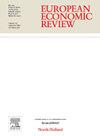Measuring top wealth shares in the UK
IF 2.4
2区 经济学
Q1 ECONOMICS
引用次数: 0
Abstract
We examine how the measurement of aggregate wealth affects our understanding of wealth distribution. We explain why choices over wealth aggregates can affect the measured level and composition of wealth concentration. Applying this to the UK, we find estimates of the top 1% wealth share vary by 2.1pp – between 14.4% and 16.5% – in 2016–18, depending on the choices we make regarding aggregates and the source of distributional information. Alternative definitions for aggregates lead to a reranking of who is at the top, replacing 40% of individuals in the top 1%, and changing the share of women and older individuals. We discuss conceptual and measurement issues with the National Accounts as a source of wealth aggregates, and argue that in many cases they are poorly aligned in both regards with the measure of personal wealth one would like to target, and in practice are less comparable internationally than they initially seem. In the UK, where the wealth survey has reasonably good coverage across the distribution, we therefore prefer survey aggregates.
衡量英国最高财富份额
我们考察了衡量财富总量如何影响我们对财富分配的理解。我们解释了为什么对财富总量的选择会影响财富集中的测量水平和构成。将其应用于英国,我们发现2016-18年,前1%的财富份额估计相差2.1个百分点,介于14.4%和16.5%之间,这取决于我们对总量和分配信息来源的选择。对财富总量的另一种定义导致了对收入最高的人的重新排序,取代了收入最高的1%中的40%,并改变了女性和老年人的比例。我们讨论了国民账户作为财富总量来源的概念和测量问题,并认为在许多情况下,它们在两个方面都与人们想要瞄准的个人财富衡量标准不太一致,而且在实践中,它们在国际上的可比性比最初看起来的要低。在英国,财富调查在整个分布范围内都有相当好的覆盖,因此我们更喜欢调查总数。
本文章由计算机程序翻译,如有差异,请以英文原文为准。
求助全文
约1分钟内获得全文
求助全文
来源期刊

European Economic Review
ECONOMICS-
CiteScore
4.70
自引率
3.60%
发文量
170
期刊介绍:
The European Economic Review (EER) started publishing in 1969 as the first research journal specifically aiming to contribute to the development and application of economics as a science in Europe. As a broad-based professional and international journal, the EER welcomes submissions of applied and theoretical research papers in all fields of economics. The aim of the EER is to contribute to the development of the science of economics and its applications, as well as to improve communication between academic researchers, teachers and policy makers across the European continent and beyond.
 求助内容:
求助内容: 应助结果提醒方式:
应助结果提醒方式:


